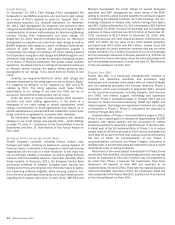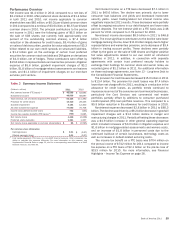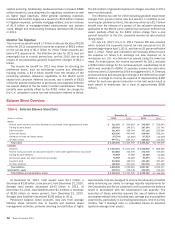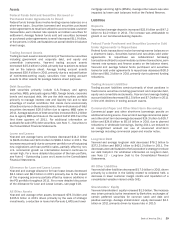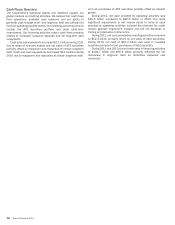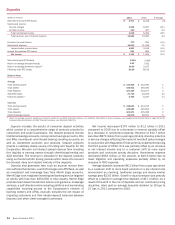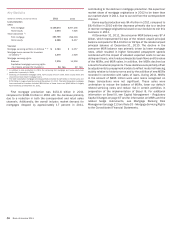Bank of America 2011 Annual Report Download - page 34
Download and view the complete annual report
Please find page 34 of the 2011 Bank of America annual report below. You can navigate through the pages in the report by either clicking on the pages listed below, or by using the keyword search tool below to find specific information within the annual report.
32 Bank of America 2011
Supplemental Financial Data
We view net interest income and related ratios and analyses on a
FTE basis, which are non-GAAP financial measures. We believe
managing the business with net interest income on a FTE basis
provides a more accurate picture of the interest margin for
comparative purposes. To derive the FTE basis, net interest income
is adjusted to reflect tax-exempt income on an equivalent before-
tax basis with a corresponding increase in income tax expense.
For purposes of this calculation, we use the federal statutory tax
rate of 35 percent. This measure ensures comparability of net
interest income arising from taxable and tax-exempt sources.
As mentioned above, certain performance measures including
the efficiency ratio and net interest yield utilize net interest income
(and thus total revenue) on a FTE basis. The efficiency ratio
measures the costs expended to generate a dollar of revenue, and
net interest yield measures the bps we earn over the cost of funds.
We also evaluate our business based on certain ratios that
utilize tangible equity, a non-GAAP financial measure. Tangible
equity represents an adjusted shareholders’ equity or common
shareholders’ equity amount which has been reduced by goodwill
and intangible assets (excluding MSRs), net of related deferred
tax liabilities. These measures are used to evaluate our use of
equity. In addition, profitability, relationship and investment models
all use Return on average tangible shareholders’ equity (ROTE) as
key measures to support our overall growth goals.
Return on average tangible common shareholders’ equity
measures our earnings contribution as a percentage of adjusted
common shareholders’ equity plus any Common Equivalent
Securities (CES). The tangible common equity ratio represents
adjusted common shareholders’ equity plus any CES divided by
total assets less goodwill and intangible assets (excluding
MSRs), net of related deferred tax liabilities.
ROTE measures our earnings contribution as a percentage of
adjusted average shareholders’ equity. The tangible equity ratio
represents adjusted total shareholders’ equity divided by total
assets less goodwill and intangible assets (excluding MSRs),
net of related deferred tax liabilities.
Tangible book value per common share represents adjusted
ending common shareholders’ equity divided by ending common
shares outstanding.
In addition, we evaluate our business segment results based
on measures that utilize return on average economic capital, a
non-GAAP financial measure, including the following:
Return on average economic capital for the segments is
calculated as net income, adjusted for cost of funds and
earnings credits and certain expenses related to intangibles,
divided by average economic capital.
Economic capital represents allocated equity less goodwill and
a percentage of intangible assets (excluding MSRs).
The aforementioned supplemental data and performance
measures are presented in Tables 7 and 8 and Statistical Tables
XII and XIV. In addition, in Table 8 and Statistical Table XIV, we have
excluded the impact of goodwill impairment charges of $3.2 billion
and $12.4 billion recorded in 2011 and 2010 when presenting
certain of these metrics. Accordingly, these are non-GAAP financial
measures.
Statistical Tables XV, XVI and XVII provide reconciliations of
these non-GAAP financial measures with financial measures
defined by GAAP. We believe the use of these non-GAAP financial
measures provides additional clarity in assessing the results of
the Corporation and our segments. Other companies may define
or calculate these measures and ratios differently.
Table 8
(Dollars in millions, except per share information)
Fully taxable-equivalent basis data
Net interest income
Total revenue, net of interest expense
Net interest yield
Efficiency ratio
Performance ratios, excluding goodwill impairment charges (1)
Per common share information
Earnings
Diluted earnings
Efficiency ratio
Return on average assets
Return on average common shareholders’ equity
Return on average tangible common shareholders’ equity
Return on average tangible shareholders’ equity
Five Year Supplemental Financial Data
2011
$ 45,588
94,426
2.48%
85.01
$0.32
0.32
81.64%
0.20
1.54
2.46
3.08
2010
$ 52,693
111,390
2.78%
74.61
$ 0.87
0.86
63.48%
0.42
4.14
7.03
7.11
2009
$ 48,410
120,944
2.65%
55.16
2008
$ 46,554
73,976
2.98%
56.14
2007
$ 36,190
68,582
2.60%
54.71
(1) Performance ratios are calculated excluding the impact of goodwill impairment charges of $3.2 billion and $12.4 billion recorded during 2011 and 2010.




